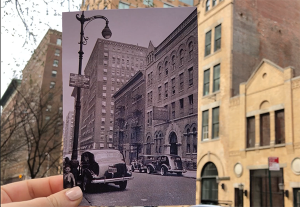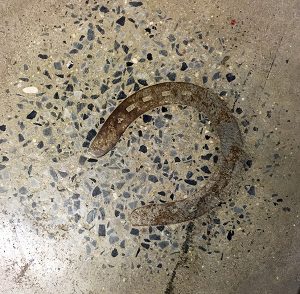This article will appear in the Winter 2021 edition of the Gaynor Gazette with additional historic photos.
 The Claremont Riding Academy trained thousands of riders over more than a century of operation, and was well known to residents of the city. Opened in 1892, it featured floors connected with ramps to house and train horses. According to the New York City Landmarks Preservation Commission’s designation in 1990, “The Claremont Stables was designed in the then-popular Romanesque Revival style by Frank A. Rooke. The three large round-arched openings at the ground story reflect the functions of the interior: an elevator entrance at the west, originally for taking carriages to upper floors for storage; a large arched door for horse traffic at the center; and at the east, the stable offices, reached by a short flight of steps, behind which are the ramps which enable the horses to reach their stalls.”
The Claremont Riding Academy trained thousands of riders over more than a century of operation, and was well known to residents of the city. Opened in 1892, it featured floors connected with ramps to house and train horses. According to the New York City Landmarks Preservation Commission’s designation in 1990, “The Claremont Stables was designed in the then-popular Romanesque Revival style by Frank A. Rooke. The three large round-arched openings at the ground story reflect the functions of the interior: an elevator entrance at the west, originally for taking carriages to upper floors for storage; a large arched door for horse traffic at the center; and at the east, the stable offices, reached by a short flight of steps, behind which are the ramps which enable the horses to reach their stalls.”
In April 2007, after years of declining business and financial stressors, the Claremont Riding Academy closed its doors for good, leaving the historic Claremont Stables building on 89th Street with an uncertain future. At the time of the closing, local press and residents lamented the loss, and wondered what was to become of the landmark building.
In 2010, Stephen Gaynor School announced the purchase of the building to house the Early Childhood Program and Middle School. Acquiring the building added more than 65,000 square feet of new space adjacent to the existing location — a truly remarkable opportunity given the limitations of Manhattan real estate. In a 2010 Gazette article announcing the development, Trustee Carol Feinberg was thanked for her leadership in the effort to acquire the stables. At that time, she remarked, “The purchase of the historic Claremont Riding Academy is a monumental move forward for Stephen Gaynor School.”
 Over the past 10 years, Gaynor has brought new life to the site, including state-of-the-art SMART and science labs, a rooftop Field House, spaces designed and dedicated to the arts and to Early Childhood learners, and in 2018, the completion of a nearly 300-seat Performing Arts Center. While many architectural elements were saved, including the historic facade and the incorporation of horseshoes into the stairwell steps, the original wood structures inside the building had to be removed because they were, as one source put it, “imbued with the smell of more than a century’s worth of manure.”
Over the past 10 years, Gaynor has brought new life to the site, including state-of-the-art SMART and science labs, a rooftop Field House, spaces designed and dedicated to the arts and to Early Childhood learners, and in 2018, the completion of a nearly 300-seat Performing Arts Center. While many architectural elements were saved, including the historic facade and the incorporation of horseshoes into the stairwell steps, the original wood structures inside the building had to be removed because they were, as one source put it, “imbued with the smell of more than a century’s worth of manure.”
From training horses and riders to educating a new generation of Gaynor students, the building has become indispensable to Stephen Gaynor School, and the school itself has become an integral chapter in the history of the Claremont Stables.
Sources:
- Roberts, Sam. “Paul Novograd, Who Owned Manhattan’s Last Public Livery, Dies at 73.” The New York Times, The New York Times, 28 Mar. 2017, www.nytimes.com/2017/03/27/nyregion/paul-novograd-dead-ran-claremont-riding-academy-in-manhattan.html
- Nir, Sarah Maslin. “Putting a Classroom Where Stables Once Stood.” The New York Times, The New York Times, 14 Dec. 2010, cityroom.blogs.nytimes.com/2010/12/14/putting-a-classroom-where-stables-once-stood/
- Hope, Bradley. “Luxury Units Set to Rise Where Horses Once Trotted.” The Sun, 28 Feb. 2008, https://www.nysun.com/real-estate/luxury-units-set-to-rise-where-horses-once-trotted/71989/
- New York City Landmarks Preservation Commission Designation, August 14, 1990. http://s-media.nyc.gov/agencies/lpc/lp/1658.pdf
